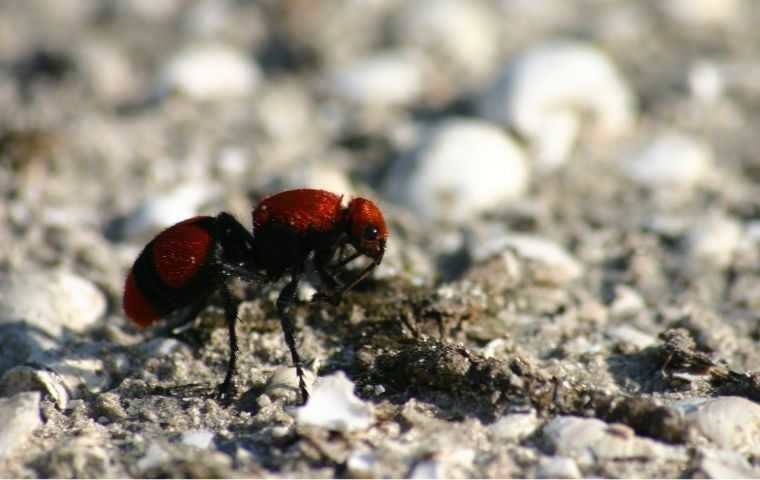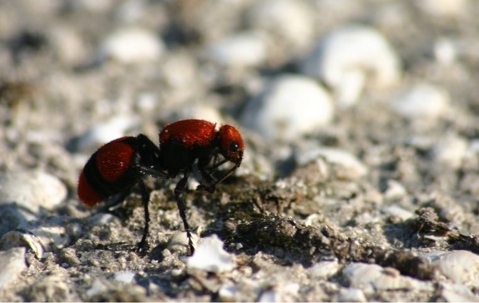Ants & Velvet Ants
September 05, 2023 - Ants

Ants and velvet ants are both members of the insect order Hymenoptera, but they exhibit several key differences in their anatomy, behavior, and biology.
Ants
Ants are remarkable insects belonging to the order Hymenoptera and the family Formicidae. They are among the most abundant and diverse terrestrial organisms on Earth, with over 12,000 known species, and likely many more yet to be discovered. These small but highly social insects have evolved to become masters of cooperation and organization, forming intricate colonies that can number from a few individuals to millions.
Ant colonies are typically structured into castes, including a single queen, sterile female workers, and, in some species, male ants. The queen's primary role is to lay eggs, while workers are responsible for various tasks such as foraging, nursing the brood, and defending the colony. Males are generally involved solely in mating, after which they often die.
Ants are known for their impressive division of labor, with workers specializing in specific roles based on their age and size. Their social organization is governed by pheromones, chemical signals they release to communicate and coordinate activities within the colony. This chemical communication allows ants to work together efficiently and navigate complex environments.
Ants are omnivorous, with their diet ranging from nectar and plant sap to small insects and other arthropods. Their foraging behaviors play a vital role in nutrient cycling and seed dispersal in various ecosystems.
Ants are highly adaptable and can be found on nearly every continent, with the exception of Antarctica. They occupy diverse habitats, including forests, grasslands, deserts, and urban areas. Some species even thrive in extreme conditions, such as deserts or rainforests.
Velvet Ants
Velvet ants, scientifically known as Mutillidae, are a distinctive family of solitary wasps found in various parts of the world. Despite their name, they are not true ants but rather wingless female wasps. These enigmatic insects are characterized by their striking appearance, vivid coloration, and unique behaviors.
Appearance: Velvet ants are easily recognizable due to their bright and velvety appearance, which varies in color, including red, orange, black, or white. Their body is covered in dense, fine hairs, giving them a soft, velvet-like texture. They have a robust, elongated body, and their females are typically wingless, while males have wings.
Life Cycle: Velvet ants are solitary insects, meaning they do not form colonies like true ants. The female velvet ant searches for the nests of other solitary bees and wasps, where she lays her eggs. When the velvet ant larva hatches, it consumes the host larva or pupa. This parasitic behavior is a notable aspect of their life cycle.
Stinger: Velvet ants are known for their potent stingers. In fact, their stings are among the most painful in the insect world, which has earned them the nickname "cow killers." Despite their painful sting, these insects are not aggressive and generally only sting in self-defense.
Habitats: Velvet ants can be found in a range of habitats, including grasslands, woodlands, and deserts. They are often encountered running along the ground, searching for the nests of their host species.
Diet: As adults, velvet ants primarily feed on nectar from flowers, making them important pollinators. They use their long tongue-like mouthparts to access nectar from deep flowers. This dietary preference contributes to the pollination of various plant species.
Sexual Dimorphism: One interesting aspect of velvet ants is their sexual dimorphism, where males and females differ significantly in appearance. Males have wings and are more wasp-like in their appearance, while females are wingless and display the characteristic velvety texture.
Warning Coloration: The vivid colors of velvet ants serve as a warning to potential predators that they possess a painful sting. This bright coloration is a form of aposematism, a warning signal that deters predators from attacking them.
Velvet ants are captivating insects known for their vibrant appearance, parasitic behavior, painful stings, and solitary lifestyle. Their unique characteristics make them a subject of fascination for entomologists and nature enthusiasts alike, contributing to the diverse tapestry of the insect world.
Ants vs Velvet Ants
Ants are social insects, living in colonies with a structured hierarchy comprising a queen, workers, and males. In contrast, velvet ants are solitary wasps, and they don't form colonies. Velvet ants are often misnamed because they are not true ants but rather wingless female wasps.
Their body structures differ significantly. Ants typically have a slender waist (called a petiole) that separates their thorax and abdomen. Velvet ants, on the other hand, have a more robust and elongated body without a noticeable waist, which is a distinctive feature separating them from ants.
Behaviorally, ants are highly organized and cooperative, with different castes specializing in tasks such as foraging, defending the colony, or reproducing. Velvet ants are solitary and do not engage in cooperative behaviors or construct nests like ants. They are known for their solitary hunting habits, typically searching for other insects to lay their eggs on, often targeting the nests of other solitary bees and wasps.
Reproductive differences also exist between the two. Ants reproduce through a process known as haplodiploidy, where unfertilized eggs become males and fertilized eggs become females. Velvet ants, on the other hand, have a more conventional reproductive system, with males and females produced from fertilized eggs.
Ants are well-known for their ability to communicate using pheromones, while velvet ants do not possess this level of chemical communication since they are solitary insects and do not require intricate colony coordination.
Customer Review
Great Service! A++ , would recommend 100%


